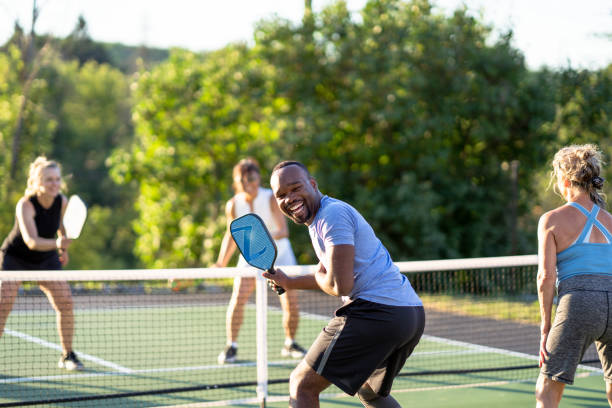Is a paddle really just a paddle? If you’ve ever held a cheap one in one hand and a high-end option in the other, you already know the answer.
Pickleball is growing fast. What was once seen as a backyard pastime is now a competitive sport drawing serious athletes and everyday players alike. But with that growth comes a question every player eventually asks: Does it actually matter what paddle I use?
What Makes a Paddle “Premium”?
There’s a reason you can walk into a sporting goods store and see paddles priced anywhere from $20 to well over $200, and it’s not just marketing.
Premium paddles aren’t just a status symbol. They’re built differently. The materials, the design, the weight distribution, even the surface texture — everything plays a role in how a paddle performs.
Let’s look at a few features that set them apart:
Core materials – Cheaper paddles often use basic polymer or even wood. Premium paddles tend to use advanced honeycomb cores, which are lighter and more responsive.
Surface technology – Higher-end paddles may have textured carbon fiber or fiberglass faces that improve ball spin and control.
Balance and weight distribution – A well-balanced paddle can drastically reduce arm fatigue and improve shot consistency.
Edge guard construction – Not just for looks, a solid edge guard protects the paddle from dings and helps maintain performance over time.
Grip quality – More cushioning, better moisture absorption, and ergonomic design all come into play with premium grips.
Why Performance Matters (Even If You’re Not a Pro)
It’s easy to assume that unless you’re playing tournaments, a standard paddle will do just fine. But anyone who plays regularly knows how big of a difference the right paddle can make, not just in results, but in how the game feels. Here’s what often changes when you move to a better paddle:
Better Control
Ball placement is everything in pickleball. You’re not just smacking it over the net; you’re aiming for feet, corners, or drop shots just over the kitchen line. A paddle with a more responsive surface and consistent sweet spot makes all of that easier to execute.
Improved Power (With Less Effort)
You don’t need to swing harder to hit harder. A high-quality paddle transfers energy better, giving you more pop with less strain. That means faster drives and put-aways that feel smooth, not forced.
Reduced Fatigue
Long games take a toll. Nice pickleball paddles, built with smarter weight distribution, help reduce that strain. That matters in long games. It’s not just about how your arm feels during the match, either. Recovery time, joint health, and even your enjoyment of the game can all take a hit if your paddle is wearing you down.
Spin Potential
If you’re playing casually, spin might not be on your radar — yet. But once you start adding topspin or slice to your shots, you’ll want a paddle that supports that technique. Many high-end paddles feature textured surfaces that grab the ball better, making spin more natural and consistent.
Durability That Pays Off
Here’s something many overlook: a paddle that performs better tends to last longer. It’s not just about avoiding cracks or breaks. Over time, cheaper paddles lose their pop, flatten out, or develop dead spots. You end up replacing them more often. A well-made paddle holds its performance longer, giving you more value over time.
Comfort Isn’t Optional
You can talk about power, spin, and shot accuracy all day, but if your hand hurts or your elbow aches, none of that matters. One of the biggest advantages of premium paddles is how they feel in the hand. The grip, the weight, the shock absorption — it all works together to reduce stress on your body.
This isn’t just a bonus feature. For players who deal with issues like pickleball elbow or wrist strain, the right paddle can be the difference between playing regularly and sitting out.
Is It Worth the Price?
This is the real debate. Because, sure, a premium paddle costs more. But what are you getting in return?
- Better gameplay experience
- Less physical strain
- Longer-lasting performance
- More room to grow your skills
That last one might be the most important. A great paddle won’t automatically make you a great player, but it does allow your skills to come through. If you’re stuck with a paddle that deadens your touch or sprays balls unpredictably, it’s going to hold you back.
Choosing One That Fits You
Even among high-end paddles, not every option suits every player. Some are designed for control. Others focus on power. Some are ultra-light. Others are slightly heavier for added punch.
It’s not about grabbing the most expensive paddle and calling it a day. It’s about finding the right match for your play style, body, and goals. Pay attention to:
- Weight – Do you prefer something light and quick or a bit heavier for stability?
- Grip size – Your paddle should feel secure and comfortable in your hand. No slipping, no over-squeezing.
- Play style – Are you a control player? A banger? Do you like to dink, drive, or do a little of everything?
If you can, try out a few paddles before committing. What feels great in someone else’s hand might not work for you. A paddle that boosts your natural strengths — that’s the one to hold onto.
It’s About More Than the Paddle
Of course, equipment is just one piece of the puzzle. You still need to practice, learn, adapt, and play smart. But when your gear is working for you instead of against you, the whole game opens up.
And that’s the real benefit. It’s not just about better shots. It’s about enjoying the game more, feeling more confident, staying out longer, pushing a little harder, and getting into that rhythm where everything clicks.


